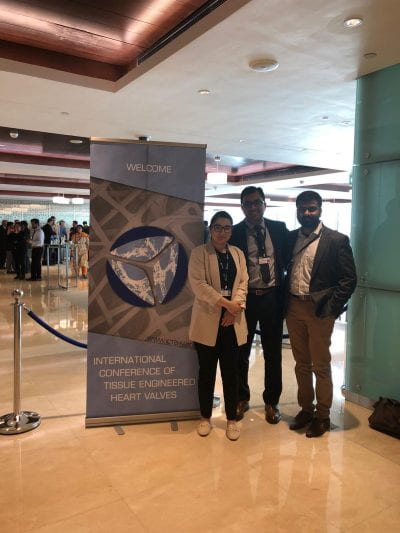A University of Arkansas biomedical engineering professor and two doctoral students presented their cardiovascular research at the International Conference of Tissue Engineered Heart Valves in Abu Dhabi earlier this semester. The conference, ICTEHV for short, holds yearly meetings all over the globe to create a dialogue between researchers that might direct and/or translate engineered heart valve treatments. The researchers traveled to the conference before travel restrictions caused by COVID-19 were in place.
Ishita Tandon and Prashanth Ravishankar are both pursuing a PhD in biomedical engineering. Tandon’s primary research focus over the last few years has been on early stages of certain cardiovascular diseases, including how these diseases are diagnosed and treated. Ravishankar’s research concentrates on the structural scaffolding of heart valves and the issues presented by the engineering of such structures.
Both are attempting to tackle diagnostic and treatment methods for aortic valve calcification. This disease, which affects up to nearly a third of the aging U.S. population, can cause constriction from calcium deposits, leading to reduced blood flow in those afflicted.
Tandon and Ravishankar work alongside Associate Professor Kartik Balachandran in his mechanobiology and soft materials laboratory. Balachandran and his lab focus on bioengineering problems presented in cardiovascular diseases and specific neurovascular disorders. It is through Balachandran’s mentorship that led the two overseas to share their research with several hundred other engineers and clinicians.
Growing up in a family of doctors, Tandon said she always knew she wanted to work with biomaterials in some way.
“Unlike other kids, my childhood dream was to develop a skin graft artificially that my father, [a burn specialist], could transplant onto a patient,” she said.
During her presentation, Tandon discussed her findings on noninvasive, early diagnostic techniques for aortic valve calcification, research for which she currently holds a predoctoral fellowship from the American Heart Association.
“Calcific aortic valve disease currently has no drug-based therapy, no mitigation or prevention strategies resulting in valve replacement as the current treatment standard,” she said. “One major challenge in intervention strategies is lack of early detection.”
Tandon said she hopes to fill that gap by developing a set of metrics that allow for early detection and, as a consequence, enhanced treatment. She placed second in the Young Researcher Award for her presentation at the conference.
Ravishankar’s research, although similar in scope, differed in trajectory, focusing on the issues that might present itself in the replacement of calcified aortic valves. To show the realities of possible treatments, Ravishankar created a 3D environment mimicking the heart. This provided a blueprint of the pre-diseased valve so that the replacement tissues could later be engineered in laboratories.
Ravishankar noted that, in addition to the importance of his and others’ research, the conference presented an invaluable opportunity for networking with other engineers in similar disciplines.
“The most important thing personally for me was the fact that you receive excellent feedback from individuals who are highly renowned in the field that strengthens your research,” he said.
Just a few months earlier, Balachandran presented his collaborative research at the 17th International Conference on Biomedical Engineering in Singapore. That research, with help from technology provided by Associate Professor Kyle Quinn’s lab, focused on the sensitivity of select detection markers for aortic valve calcification. He presented an update of this work at ICTEHV in Abu Dhabi, one that focused on identifying the signaling mechanisms that maintain the aortic valve in its healthy, pre-diseased state.
“I am extremely proud of Ishita and Prashanth for their dedication and to Dr. Balachandran for actively promoting his students to conduct critical research to address cardiovascular diseases. I would also like to thank the Graduate School for their generous support to our students”, said Raj Rao, professor and department head of biomedical engineering.
Both students said they hope to push their research beyond the walls of the university. Ravishankar plans on pursuing industry so as to create lifesaving products. Tandon will continue with postdoctoral research in an effort to put the newest technologies on the market for consumers and improve patient care.

